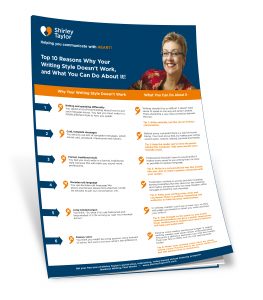Article written by Shirley Taylor
FREE CHECKLIST! Scroll down to receive my special checklist 'Top 10 Reasons Why Your Writing Style May Not Be Working And What You Can Do About It'.
Do you think using big words and long sentences will impress your readers?
Do you think using a long phrase is better than one word?
Do you think it's fine to use abbreviations, jargon and management buzzwords?
Do you use phrases like Please be informed at the beginning of some sentences?

If you answered yes to any of these questions, you may be making your business writing much more difficult than it should be. And more importantly, you're making reading much more difficult for your reader.
I'm really happy to see that more organisations are taking action to simplify their language in official business documents and messages. This movement is called plain English.
With limited time and so much mail in our inboxes, readers want to read messages that are simple and clear. Readers want to read and understand messages easily, and know exactly how to reply. Readers today deserve plain English.
If your readers are confused or can't focus when reading your messages, you could be missing out on countless business opportunities. Writing in plain English will mean you can click 'send' with confidence, and your reader will easily understand what you're saying. And that means you are more likely to get the right response.
What Is Plain English?
Plain English is writing that's fuss-free and 'fluff-free'. It's easy to read, and easy to understand. Plain English involves using short, clear sentences with everyday words. Plain English contains no redundancies or jargon.
Tips for Writing In Plain English
Using plain English will help you and it will also help your readers. So before hitting 'send', here are some tips to help you fine-tune your messages.
1. Delete any redundant introductions in your sentences, like Please be informed, Kindly be advised, I am writing to inform you. Just get straight to the point.
2. Simplify long or old-fashioned words, for example use share or distribute instead of disseminate, agree instead of concur, about instead of regarding, please instead of kindly. Use everyday words.
3. Look for long phrases that could be reduced to a simple active verb, such as conclude instead of come to a conclusion, improve instead of make an improvement, sign instead of help me to sign. Focus on active verbs.
4. Remove unnecessary words in phrases such as these: 3am in the morning, advance notice, basic fundamentals, in accordance with, in order to, and repeat again. Using unnecessary or redundant words makes your writing weaker. Avoid redundancies.
5. Watch out for jargon and buzzwords like think out of the box, moving forward, double down, and game changer. Consider how you can delete them or say such phrases differently. Keep your sentences crisp and clear.
6. Be careful with acronyms. There may be several possibilities and too much room for misunderstanding, so it's safer not to use them. For example, some people use FYA to mean for your action, while others mean for your approval. Avoid acronyms.
7. Put the reader's head on. Read it as though you are the reader, and if anything is not quite clear, change it. Simple, clear and precise language will help you cut down on all the email ping-pong that's happening in inboxes all over the globe. It will also help you to achieve better results. Make your writing reader-friendly.
Make To Learn More About Plain English?
The information in this article is a powerful sample of what I'm offering in my interactive, video-based virtual training program. Would you like to improve your business writing by working with me virtually, as though we are one-on-one? I can show you how to craft clear, concise messages that get your message across effectively and get you great results. Better still, if you think this is something your whole team could benefit from, let's work together so we can embed good writing throughout your organisation.
To help you, I've put together a checklist of reasons why the writing style in your organisation may not be working as effectively as it should. This checklist also contains my top 10 strategies for improving the business writing style throughout your organisation.

